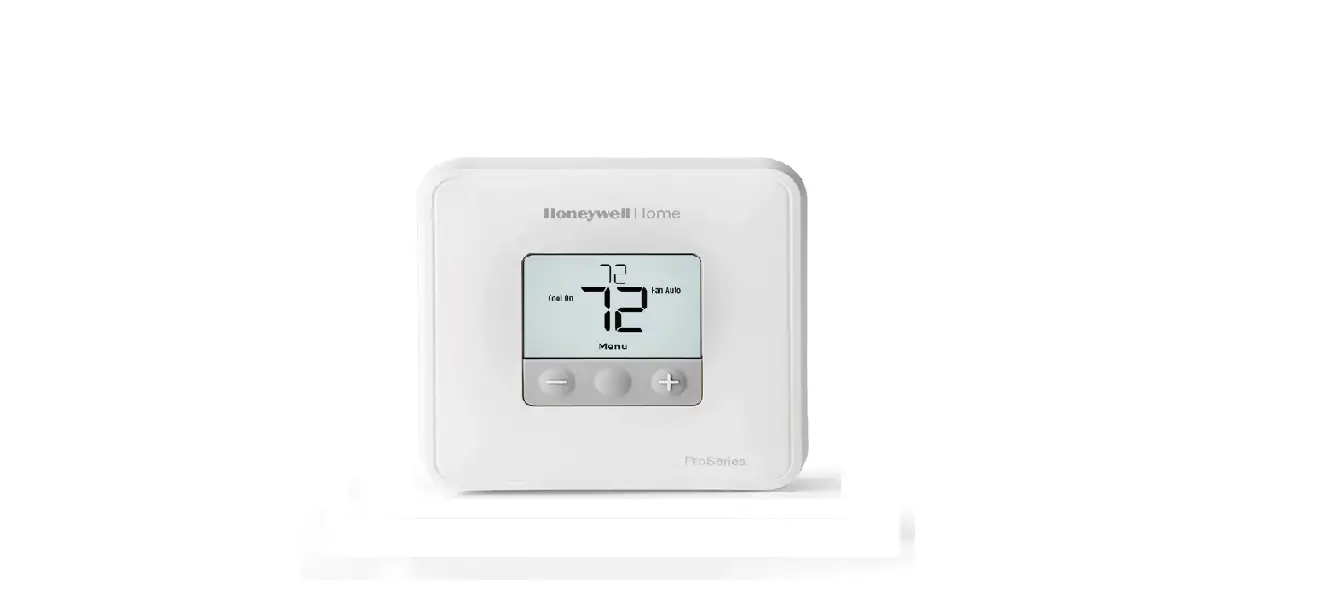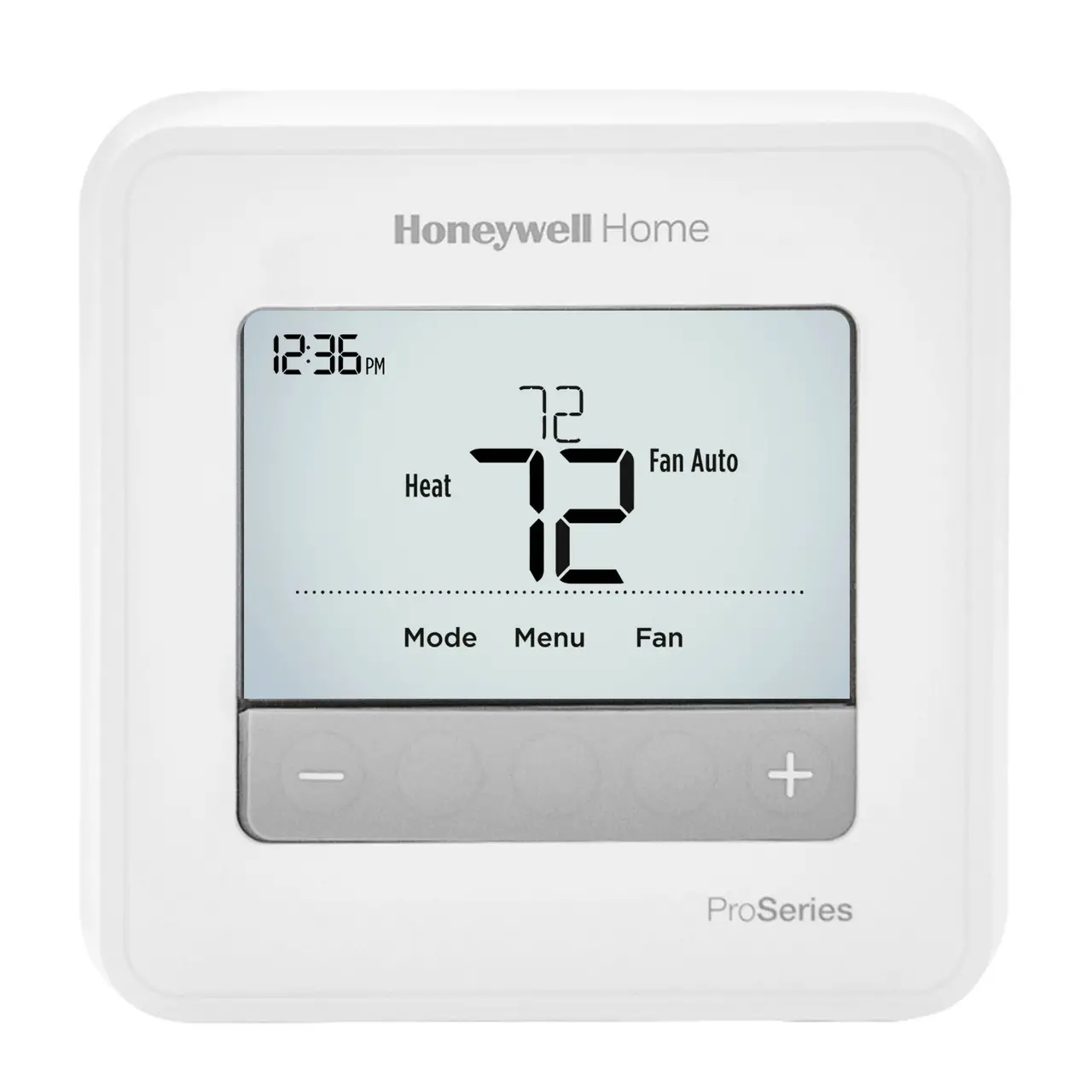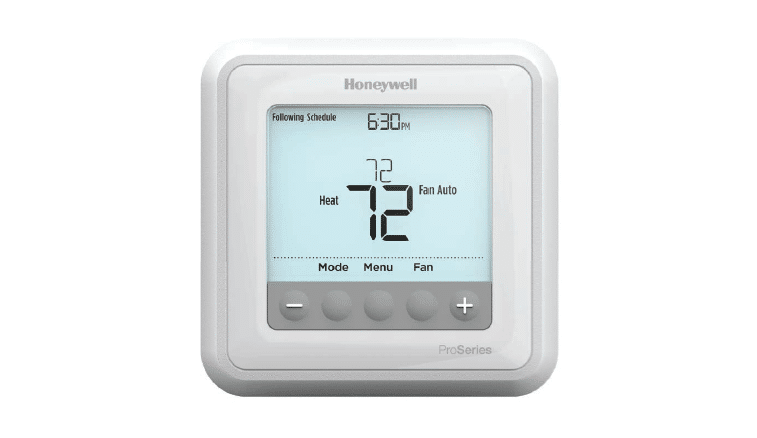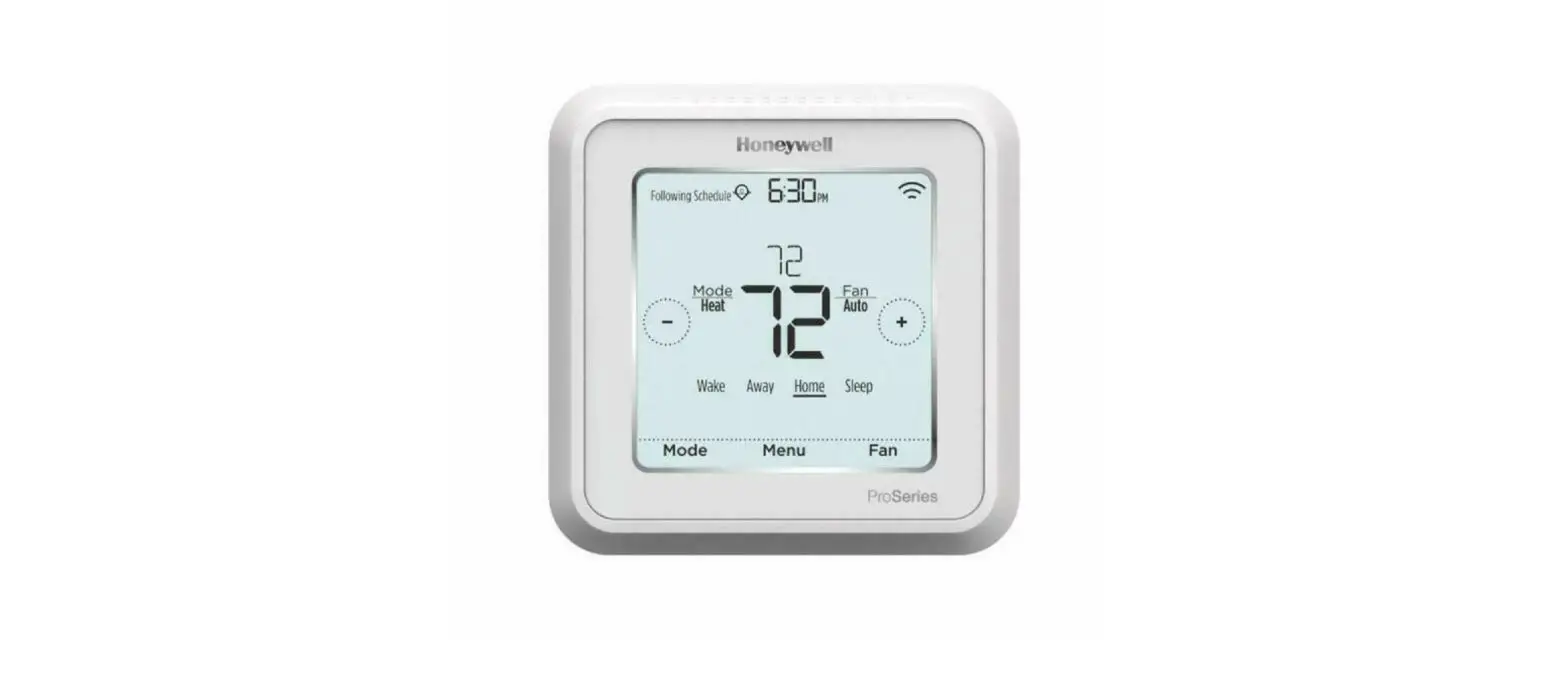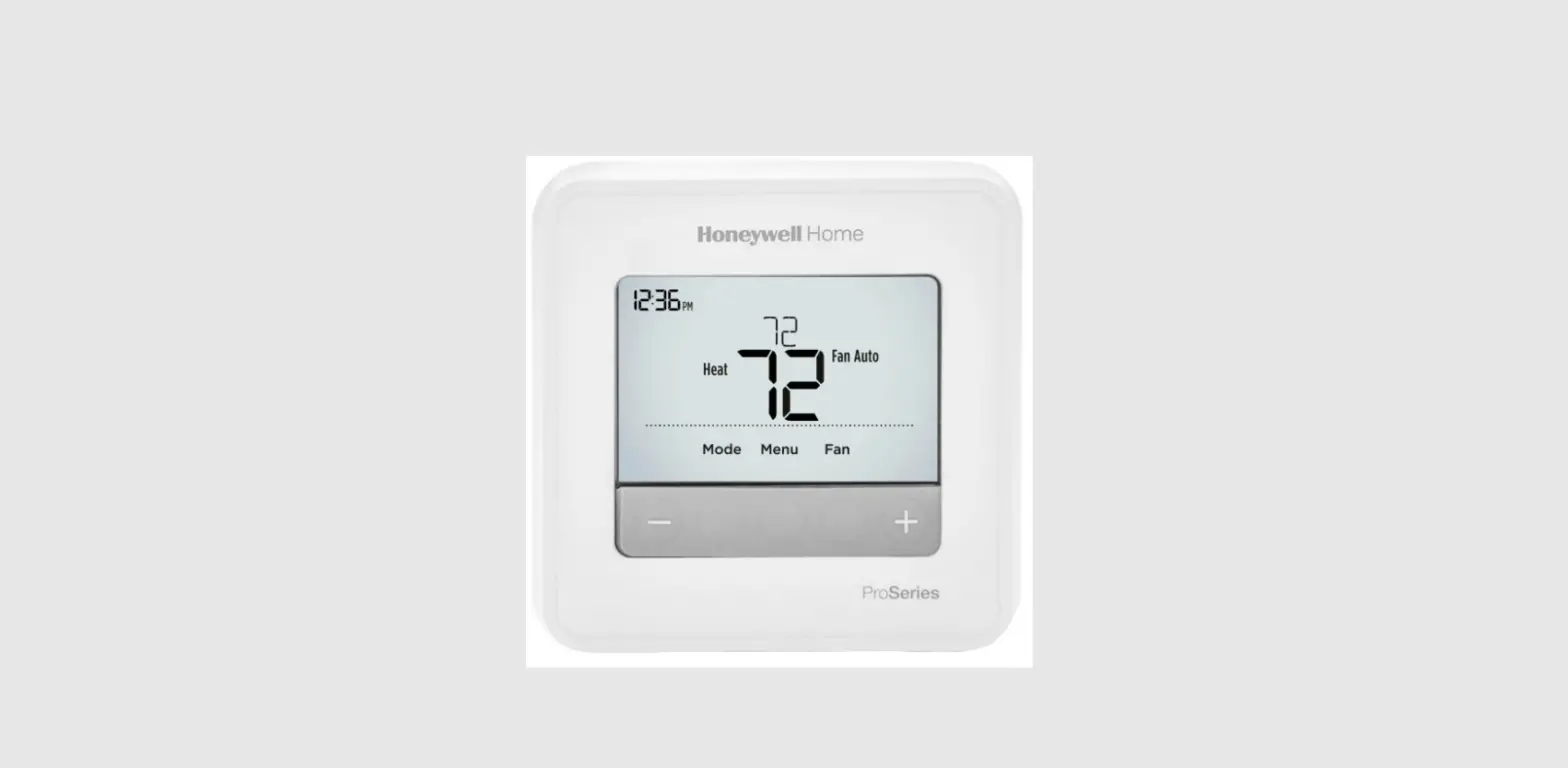Honeywell Pro Series Thermostat
 Honeywell Pro Series Thermostat
Honeywell Pro Series ThermostatModel : T6 Pro
Other Honeywell Pro Thermostat Manuals:
- T4 Pro
- T6 Pro
- RTH5160 Non-Programmable Thermostat
- WiFi Touchscreen Thermostat Installation Manual
- WiFi Color Touchscreen Thermostat
- VisionPRO WiFi Thermostat
Package Includes
- T6 Pro Thermostat
- UWP Mounting System
- Honeywell Standard Installation Adapter (J-box adapter)
- Honeywell Decorative Cover Plate –Small; size 4-49/64 in x 4-49/64 in x11/32 in (121 mm x 121 mm x 9 mm)
- Screws and anchors
- 2 AA Batteries
- Installation Instructions and User Guide
Optional Cover Plate installation
NOTE: If Optional Cover Plate is not required, see “UWP Mounting System installation” on next page.
Use the Optional Cover Plate when:
- Mounting the thermostat to an electrical junction box
- Or when you need to cover paint gap from old thermostat.
- Separate the Junction Box Adapter from the Cover Plate. See Figure 1.

- Mount the Junction Box Adapter to the wall or an electrical box using any of the eight screw holes. Insert and tighten mounting screws supplied with Cover Plate Kit. Do not overtighten. See Figure 2. Make sure the Adapter Plate is level.
- Attach the UWP by hanging it on the top hook of the Junction Box Adapter and then snapping the bottom of the UWP in place. See Figure 3.

- Snap the Cover Plate onto the Junction Box Adapter. See Figure 4.
 UWP Mounting System installation
UWP Mounting System installation - Before starting, turn the power off at the breaker box or switch. Open package to find the UWP. See Figure 5.
- Position the UWP on wall. Level and mark hole positions. See Figure 6. Drill holes at marked positions, and then lightly tap supplied wall anchors into the wall using a hammer.
Drill 7/32” holes for drywall.
- Pull the door open and insert the wires through wiring hole of the UWP. See Figure 7.
- Place the UWP over the wall anchors. Insert and tighten mounting screws supplied with the UWP. Do not overtighten. Tighten until the UWP no longer moves. Close the door. See Figure 8.
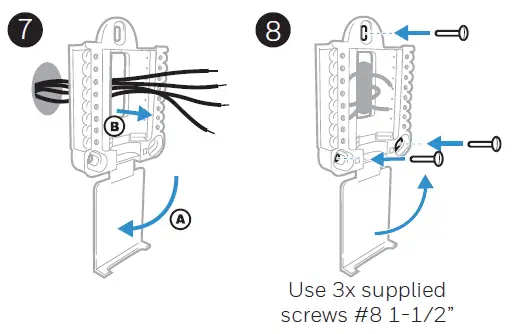
Power options
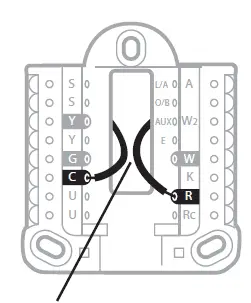
Insert R and C wires into designated terminals for primary AC power (C terminal is optional if batteries are installed, but it is recommended). Remove wires by depressing the terminal tabs.
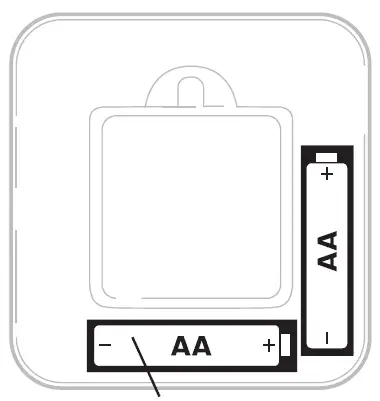
Insert AA batteries for primary or backup power.
Setting Slider Tabs
Set R Slider Tab
- Use built-in jumper (R Slider Tab) to differentiate between one or two transformer systems.
- If there is only one R wire, and it is connected to the R, Rc, or RH terminal, set the slider to the up position (1 wire).
- If there is one wire connected to the R terminal and one wire connected to the Rc terminal, set the slider to the down position (2 wires).

NOTE: Slider Tabs for U terminals should be left in place for T6 Pro models.
Wiring terminal designations
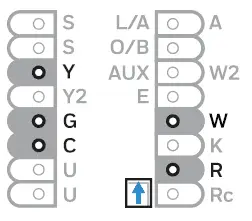
Note: Not all terminals may be used, depending on the system type that is being wired. The most commonly used terminals are shaded.
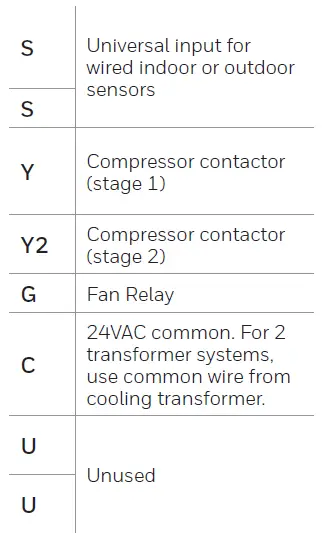
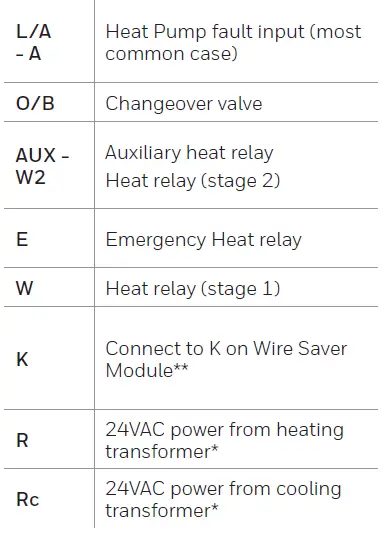
- Terminal can be jumped using Slider Tab. See “Setting Slider Tabs” above.
- The THP9045A1023 Wire Saver Module is used on heat/cool systems when you only have four wires at the thermostat, and you need a fifth wire for a common wire. Use the K terminal in place of the Y and G terminals on conventional or heat pump systems to provide control of the fan and the compressor through a single wire—the unused wire then becomes your common wire. See THP9045 instructions for more information.
Wiring conventional systems: forced air and hydronics
Shaded areas below apply only to TH6320U/TH6220U or as otherwise noted.
- 1H/1C System (1 transformer)
- R Power [1]
- Rc [R+Rc joined by Slider Tab] [2]
- Y Compressor contactor
- C 24VAC common [3]
- W Heat relay
- G Fan relay
Heat-only System
- R Power [1]
- Rc [R+Rc joined by Slider Tab] [2]
- C 24VAC common [3]
- W Heat relay
Heat-only System (Series 20) [5]
- R Series 20 valve terminal “R” [1]
- Rc [R+Rc joined by Slider Tab] [2]
- Y Series 20 valve terminal “W”
- C 24VAC common [3]
- W Series 20 valve terminal “B”
Heat-only System (power open zone valve) [5]
- R Power [1]
- Rc [R+Rc joined by Slider Tab] [2]
- W Valve
- C 24VAC common [3]
1H/1C System (2 transformers)
- R Power (heating transformer) [1]
- Rc Power (cooling transformer) [1]
- Y Compressor contactor
- C 24VAC common [3, 4]
- W Heat relay
- G Fan relay
Heat-only System with Fan
- R Power [1]
- Rc [R+Rc joined by Slider Tab] [2]
- C 24VAC common [3]
- W Heat relay
- G Fan relay
Cool-only System
- R Power [1]
- Rc [R+Rc joined by Slider Tab] [2]
- Y Compressor contactor
- C 24VAC common [3]
- G Fan relay
2H/2C System (1 transformer) [6]
- R Power [1]
- Rc [R+Rc joined by Slider Tab] [2]
- Y Compressor contactor (stage 1)
- C 24VAC common [3]
- W Heat relay (stage 1)
- G Fan relay
- W2 Heat relay (stage 2)
- Y2 Compressor contactor (stage 2)
NOTES
Wire specifications: Use 18- to 22-gauge thermostat wire. Shielded cable is not required.
- Power supply. Provide disconnect means and overload protection as required.
- Move R-Slider Tab on UWP to the R setting. For more information, see “Setting Slider Tabs” on page 3
- Optional 24VAC common connection.
- Common connection must come from cooling transformer.
- In ISU set Heat system type to Radiant Heat. Set number of cool stages to 0.
- In Installer Setup, set system type to 2Heat/2Cool Conventional
Wiring heat pump systems
Shaded areas below apply only to TH6320U/TH6220U or as otherwise noted.
- 1H/1C Heat Pump System
- R Power [1]
- Rc [R+Rc joined by Slider Tab] [2]
- Y Compressor contactor
- C 24VAC common [3]
- O/B Changeover valve [7]
- G Fan relay
2H/1C Heat Pump System [8]
- R Power [1]
- Rc [R+Rc joined by Slider Tab] [2]
- Y Compressor contactor
- C 24VAC common [3]
- O/B Changeover valve [7]
- G Fan relay
- Aux Auxiliary heat
- E Emergency heat relay
- L Heat pump fault input
2H/2C Heat Pump System [9]
- R Power [1]
- Rc [R+Rc joined by Slider Tab] [2]
- Y Compressor contactor (stage 1)
- C 24VAC common [3]
- O/B Changeover valve [7]
- G Fan relay
- Y2 Compressor contactor (stage 2)
- L Heat pump fault input
3H/2C Heat Pump System (TH6320U only) [10]
- R Power [1]
- Rc [R+Rc joined by Slider Tab] [2]
- Y Compressor contactor (stage 1)
- C 24VAC common [3]
- O/B Changeover valve [7]
- G Fan relay
- Aux Auxiliary heat
- E Emergency heat relay
- Y2 Compressor contactor (stage 2)
- L Heat pump fault input
Dual Fuel System
- R Power [1]
- Rc [R+Rc joined by Slider Tab] [2]
- Y Compressor contactor (stage 1)
- C 24VAC common [3]
- O/B Changeover valve [7]
- G Fan relay
- Aux Auxiliary heat
- E Emergency heat relay
- Y2 Compressor contactor (stage 2 – if needed)
- L Heat pump fault input
- S Outdoor sensor
- S Outdoor sensor
NOTES
Wire specifications: Use 18- to 22-gauge thermostat wire. Shielded cable is not required.
- Power supply. Provide disconnect means and overload protection as required.
- Move R-Slider Tab on UWP to the R setting. For more information, see “Setting Slider Tabs” on page 3
- Optional 24VAC common connection.
- In Installer Setup, set system type to 2Heat/2Cool Conventional.
- In Installer Setup, set changeover valve to O (for cool changeover) or B (for heat changeover).
- In ISU set Heat system type to Heat pump. 1 compressor and 1 stage of backup heat.
- In ISU set Heat system type to Heat pump. 2 compressors and 0 stage of backup heat.
- In ISU set Heat system type to Heat pump. 2 compressors and 1 stage of backup heat.
Thermostat mounting
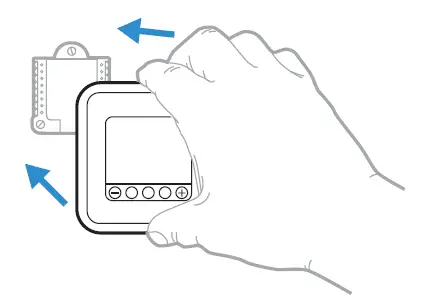
- Push excess wire back into the wall opening.
- Close the UWP door. It should remain closed without bulging.
- Align the UWP with the thermostat, and push gently until the thermostat snaps in place.
- Turn the power on at the breaker box or switch.
System operation settings
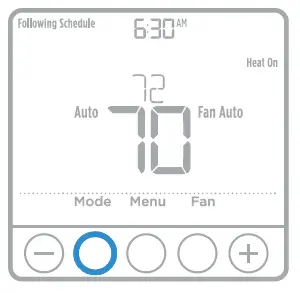
- Press the Mode button to cycle to the next available System mode.
- Cycle through the modes until the required System mode is displayed and leave it to activate.
NOTE: Available System modes vary by model and system settings.
System modes:
- Auto
- Heat
- Cool
- Em Heat
- Off
Fan operation settings
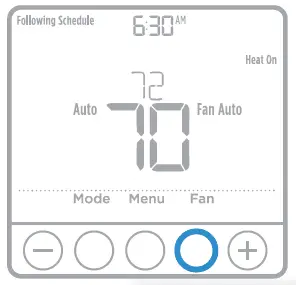
- Press the Fan button to cycle to the next available Fan mode.
- Cycle through the modes until the required Fan mode is displayed and leave it to activate.
NOTE: Available Fan modes vary with system settings.
Fan modes:
- Auto: Fan runs only when the heating or cooling system is on.
- On: Fan is always on.
- Circ: Fan runs randomly about 33% of the time.
Installer setup (ISU)

- Press and hold CENTER and + buttons for approximately 3 seconds to enter advanced menu.
- Press Select to enter ISU.
- Press Select to cycle through menu setup options.
- Press + or – to change values or select from available options.
- Press Select and confirm your settings or press Back to ignore changes and return to ISU menu screen to continue editing another setup option.
- To finish setup process and save your setting, press Home and return to Home screen.
NOTE: A complete list of all setup (ISU) parameters and options starts below and continues through page 10.
Advanced setup options (ISU)
NOTE: Depending on system settings, not all options may be available.
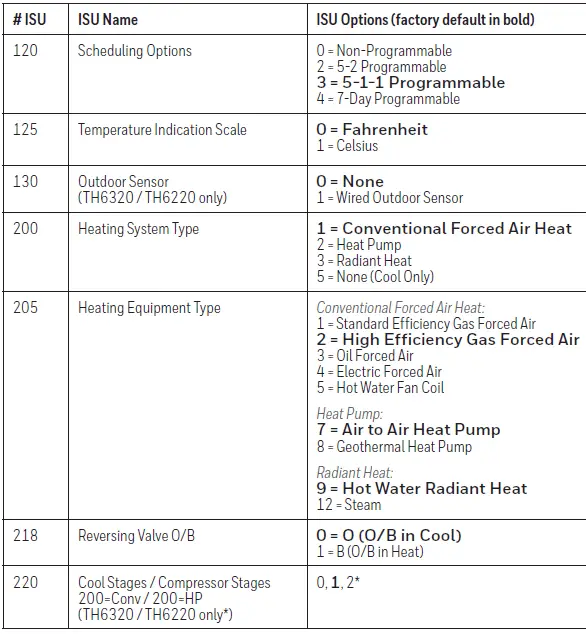
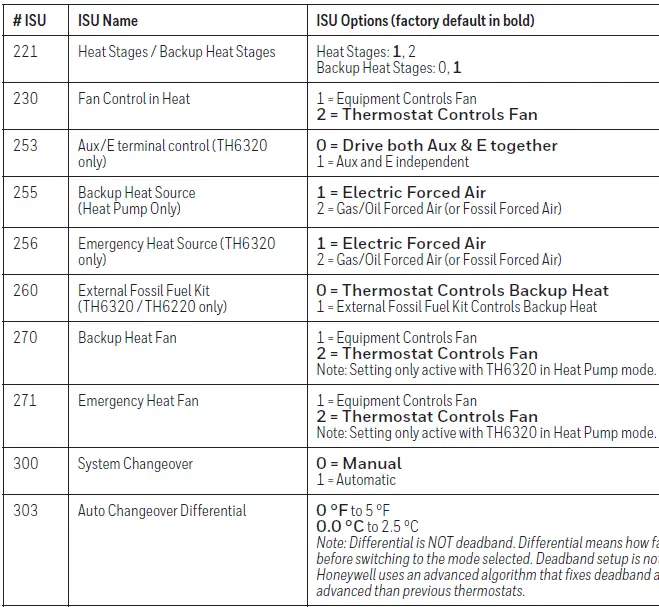
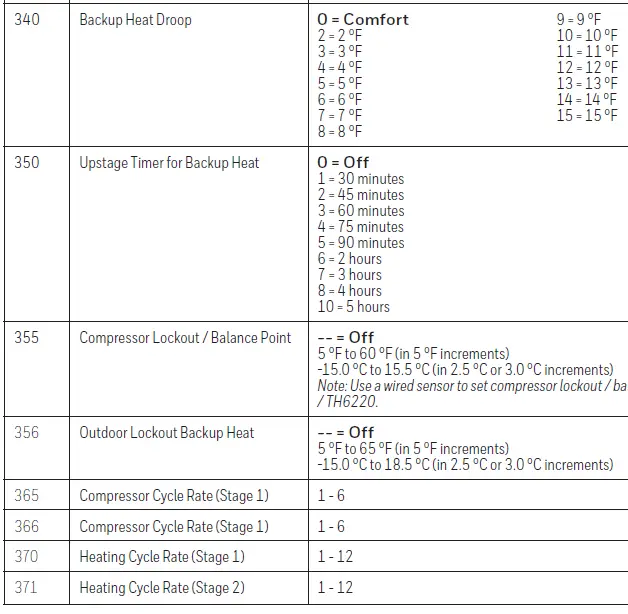
Installer system test
To perform a System Test:
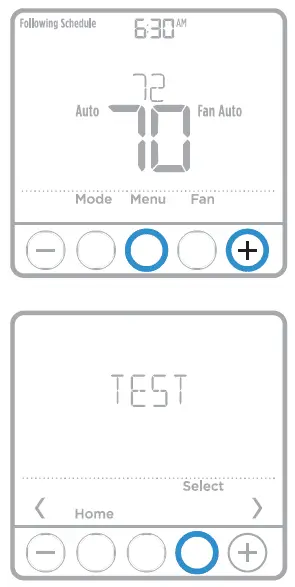
- Press and hold CENTER and + buttons for approximately 3 seconds to enter advanced menu.
- Use + to go to TEST. Press Select to enter System Test.
- Use + to change between Heat, Cool, Fan, Em Heat, or Ver (thermostat version information). Press Select.
- Press + to turn stages on one at a time, and press – to turn them off.
- Use the Home button to exit the System Test.
System test System status
Shaded areas below apply only to TH6320U/TH6220U or as otherwise noted.
Default security code
The default security code for the Honeywell Pro Series thermostat is 1234
Heat
0 All Off
1 Heat Stage 1 on
2 Heat Stage 2 also on
3 Heat Stage 3 also on
Cool
0 All Off
1 Cool Stage 1 on
2 Cool Stage 2 also on
Em Heat
0 All Off
1 Em Heat on
Fan
0 Fan Off
1 Fan On
Specifications
Temperature Ranges
Heat: 40 °F to 90 °F (4.5 °C to 32.0 °C)
Cool: 50 °F to 99 °F (10.0 °C to 37.0 °C)
Working Ambient Temperature
32 °F to 120 °F (0 C° to 48.9 °C)
Operating Ambient Temperature
37 °F to 102 °F (2.8 °C to 38.9 °C)
Shipping Temperature
-20 °F to 120 °F (-28.9 °C to 48.9 °C)
Operating Relative Humidity
5% to 90% (non-condensing)
Physical Dimensions in inches (mm) (H x W x D)
4-1/16” H x 4-1/16” W x 1-5/32” D
103.5 mm H x 103.5 mm W x 29 mm D
Electrical Ratings

CAUTION: ELECTRICAL HAZARD
Can cause electrical shock or equipment damage. Disconnect power before
beginning installation.
CAUTION: EQUIPMENT DAMAGE HAZARD
Compressor protection is bypassed during testing. To prevent equipment damage, avoid cycling the compressor quickly.
CAUTION: MERCURY NOTICE
If this product is replacing a control that contains mercury in a sealed tube, do not place the old control in the trash. Contact your local waste management authority for instructions regarding recycling and proper disposal.
Pull to remove the thermostat from the UWP
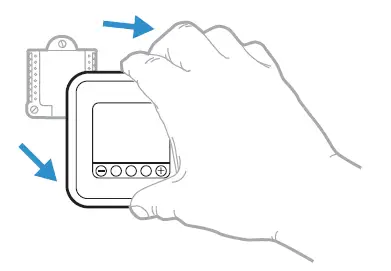
Customer assistance
For assistance with this product, please visit customer.honeywell.com
Or call Honeywell Customer Care toll-free at
1-800-468-1502.
Automation and Control Solutions
Honeywell International Inc.
1985 Douglas Drive North
Golden Valley, MN 55422
customer.honeywell.com
® U.S. Registered Trademark.
© 2016 Honeywell International Inc.
33-00181EFS—01 M.S. 06-16
Printed in U.S.A.
Printed in U.S.A.
FAQS
Yes, but “System Changeover” in the ISU menu must be changed from the default value of 0 (“Manual”) to 1 (“Automatic”), then “Auto” can be selected as one of the operating modes using the “Mode” button.
Yes, it’s a low-voltage (24 VAC) thermostat, compatible with the vast majority of forced air HVAC systems.
No goes by cycles per hour you program in , This is a smart stat, adjusts itself to maintain that 3 degree swing. Gas or Oil 3-5 times a hour is good, heat pump 5-7 times a hour
no. need a wifi stat for that. But is a good thermostat.
This thermostat does not have a wifi connection it will not work with Alexa, phone, or any device. It must be programmed on the thermostat itself by pushing buttons although it is digital. It’s a very nice thermostat and works great.
A couple of possible and easy to address reasons. First, you may have the fan set to “circulate”, which means the thermostat turns the furnace blower on periodically to circulate air throughout the home. If so, set the fan to “auto” on the front of the thermostat. Second possible reason, you may have an separate air circulation system hooked to the furnace fan to circulate and introduce fresh air into the home. This system is common in newer, sealed, homes built in past 15 or so years. If so, check to see what the programmed schedule for this separate device (typically mounted to the exterior of the furnace) is set to operate and adjust if desired.
I had to use touch up paint because the thermostat is smaller than the previous one and I had painted the room after moving in my home.
If by dual fuel you mean one source for heat and a different source for A/C, then yes. I have gas heat and electric air on two separate units and have this thermostat controlling both units.
2-programs per day or 4-programs per day, or no programs per day adjustable for 5-1-1, or 5-2days, as far as off and on, can not do that just to the lowest, or highest temp.
T4 is a basic stat that works on batteries or 24vac, it is no programmable good for milli volt fireplaces, or furnaces. T5 does not have emergency heat for heat pumps, t6 has programming capability select able requires 24 vac from furnace. still has batteries just to maintain setback programs
Absolutely YES. Everything is returnable. — If dealing with a shady company, then you may have to pay the return shipping and file a claim with your credit card company, to have your money refunded, but credit cards are a CONSUMER PROTECTION device, so that’s why we use them 🙂
Sometimes annoying. To change one time, cycle or temp program, you have to go through too many program changes. For instance you have to go through separate ac, and heat programs for each step. Temporary or locked permanent temperature changes however are easy.
t6 lyric
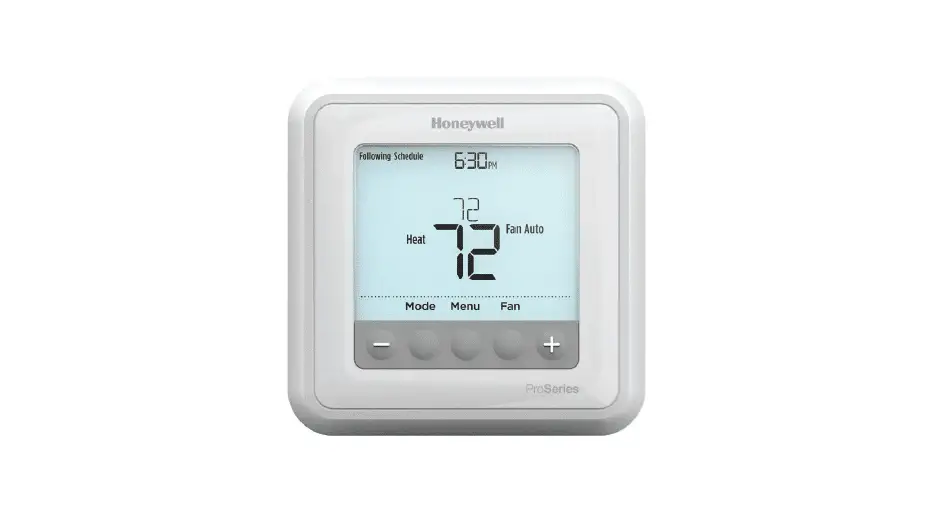



 UWP Mounting System installation
UWP Mounting System installation
